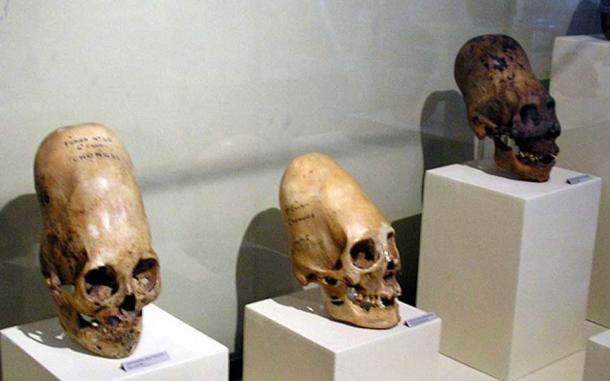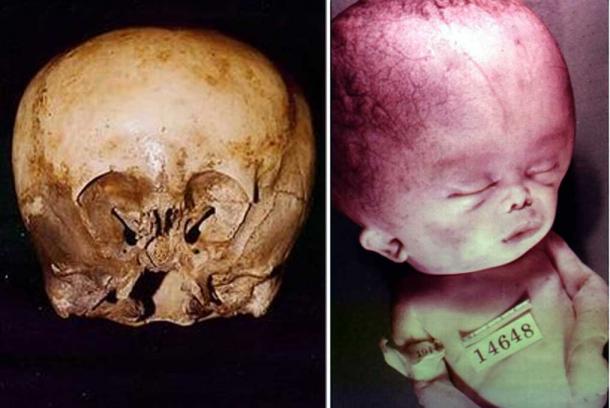
Elongated Skulls Increased Kudos in Ancient Peru
Archaeologists dig them up all over the ancient world from Egypt to Peru, and now, these curious elongated skulls are believed to have been “status symbols,” according to a recent paper in Current Anthropology. The ruling elite in parts of ancient South America artificially extended their skulls to "bind communities together with a collective identity,” according to Bioarchaeologist Matthew Velasco of Cornell University.
Although cranial deformation is generally associated with the Inca civilization, more than half a century before they came to dominate the west coast of the Americas “cranial deformation” or “skull binding” was developed by the Collagua people. In southern Peru the Colca River runs for about 450 kilometers before flowing into the Pacific Ocean and it was home of the Collaguas and the Cavanas.

Possible methods used by the Collagua people to shape a child's head. (Public Domain)
In his 1966 book The Human Skull: A Cultural History, scholar Folk Henschen explained that this skull shape was achieved by “small boards tied around children’s heads,” compressing the growing skull and forcing it to elongate. Velasco believes these people “intentionally created tall thin skull shapes,” made these aesthetic modifications to bind "the powerful elite together.” Spanish accounts state that the Cavanas also modified their skulls, widening and flattening them, in contrast to the Collaguas, but this practice was forbidden in the early 16th century.
- New DNA Testing on 2,000-Year-Old Elongated Paracas Skulls Changes Known History
- The Story Of Elongated Skulls And The Denied History Of Ancient People: An Interview With Mark Laplume
- Elongated Human Skulls Of Peru: Possible Evidence Of A Lost Human Species?

A case of skulls from the Andean Paracas culture, as seen in the Museo Nacional de Arqueología, Antropología e Historia del Perú in Lima. They illustrate head flattening practiced in this culture's elite. (CC BY-SA 3.0)
Mr Velasco was the first archaeologist to consider these skulls shapes “as class differentiators within the Collagua” and to test the validity of his suspicions, he examined over 200 skulls from a 300-year period. According the research paper, Mr Velasco’s team noticed “tall thin skulls became increasingly linked to high social status.” The primary observation leading to this conclusion was that females with elongated skulls “ate a broader diet than those without cranial alterations” and these women had endured “fewer injuries from physical attacks than women with unaltered skulls,” Science News reports.
Summarizing his finds Mr Velasco said “Greater standardization of head-shaping practices echoes broader patterns of identity formation across the south-central highlands and may have provided a symbolic basis for the cooperation of elite groups during an era of intensive conflict.”
- Initial DNA analysis of Paracas elongated skull released – with incredible results
- New study reveal origins of elongated skulls in the Carpathian Basin
- Why Did Parents in the Chinookan tribe Perform Cranial Deformation on their Babies?

These skulls are on display at Museo Regional de Ica in the city of Ica in Peru. (CC BY 2.0)
Meanwhile, alternative historians present these oddities as having extraterrestrial origins, belonging to unknown subspecies of human being, or that they are descendants from Atlantis. You generally find these researchers sharing their deep insights at “Truth” type conferences with like-minded folk. They all clap together when jabs are made at “accepted” archaeology and anthropology and the two most often repeated lies are “Elongated skulls are larger than normal skulls” and “cranial deformation cannot increase the volume of the skull!” Because no scientists attend such events, nobody stands up and says, “Hold on mate, what you just said is a load of rubbish. You just made that up.”
Sometimes, when book sales are required, elongated skull researchers get carried away and archaeologically, for a few weeks, things get really bent out of shape. The most famous modern skull scam was the “Starchild” incident, when the skeleton of a five-year-old child was discovered in a cave in Mexico dated to about 900 years old. The skull was exceptionally bulbous, just like "gray aliens,” says the skull's owner, Ray Young, who promotes the skull as “alien, or possibly an alien-human hybrid.”

The ‘Starchild’ skull (left).(Fair Use) Photo of baby with hydrocephalus(right). (GFDL)
The scientific sector and humans beings with a mature disposition quite readily accepted the reports of neurologists who explained that the “Starchild” had hydrocephaly, a condition where a build-up of fluid causes the young pliable skull to expand. What’s more, a 2003 dna test established that the child had “normal human DNA and was male, having both X and Y chromosomes,” therefore it had a human father and mother. However, a tad embarrassingly, Young (and other support) continues to tout his “alien-human hybrid theory” in the face of a really well understood illness that affected children.

Proto Nazca deformed skull, c 200-100 BC. (CC BY-SA 4.0)
Today, we buy cars, clothes and jewelry to indicate our social status, but the ancient people of southern Peru, without malls, adopted “skull binding.” By simply binding wooden blocks to a child’s head with fabric or leather, they would assure they grew up with an oval shaped head. With this simple process being so well understood, anthropologists and archaeologists must find it very disheartening to see grown men touting ‘alien’ and ‘lost civilization theories.’ As they sweat their lives away in trenches, breaking their backs, digging up our past, alternative archaeologists come along and begin challenging them and clouding people’s understanding of history as they indulge in their dying 60s ideologies.
Talking of every and all theory which diverts from the “skull binding” model of how these skulls came to be elongated, leading skeptic Brian Dunning, in a skeptoid.com article, eloquently said: “The elongated skulls of Peru are certainly interesting, but their origin is well understood and no mystery exists outside of the delusions of those who insist on alien or supernatural explanations for just about anything.”
Top image: Skulls from the Andean Paracas (top left). (CC BY-SA 3.0); Paracas skull at Ica Museum(right). (CC BY 2.0); Child head shaping methods (bottom left). (Public Domain).
By Ashley Cowie
















Comments
Curiously, the most important anatomic anomalies are conveniently ignored (i.e. sagittal suture and foramen magnus) and the author proceeds to dismiss claims as lies without offering any evidence. Laughably, a classic argumentation failure takes place in the form of changing the topics (i.e. strawman). Who gives a shit about starchild, which appears to be a single anomaly?
It all started to sound like an article from the average sceptic site and alas, we got a nice link to a site, which intellectually dishonestly handles a complicated matter in a few paragraphs. Truely, an approach for the shorter attention span.
It is not my job to teach you the scientific method or list all the inaccuracies of the poor sceptic, I'm sure you can do your own research - at least that's what I assume when I read this site.
Please don't fail again this badly in the future, take care.